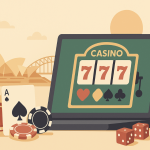Imagine playing bridge in your pyjamas, sipping coffee, and competing with players from around the world.
Navigating the Shift: How Online Bridge is Changing the Game

Navigating the Shift: How Online Bridge is Changing the Game
Imagine playing bridge in your pyjamas, sipping coffee, and competing with players from around the world. Welcome to online bridge – where the future of this classic card game is happening right now! Bridge isn’t just for quiet card rooms anymore – it’s gone digital, and it’s more exciting than ever. Now, you can play it anytime, anywhere, with anyone across the globe. This isn’t a passing trend – it’s a game-changer that’s reshaping how we play bridge.
Whether you’re a pro or just starting out, there’s never been a better time to join the bridge community. From global games to AI partners, from late-night tournaments to virtual clubs – online bridge is dealing out new opportunities for everyone.
Let’s take a look at the exciting world of online bridge.
The Rise of Online Bridge Platforms
One of the most significant advantages of online bridge is its ability to connect players from across the globe. No longer constrained by physical location, enthusiasts can now find partners and opponents from different countries and cultures, enriching the gaming experience. This global connectivity has led to a melting pot of playing styles and strategies, fostering a more diverse and dynamic bridge community.
Players from New York can now regularly compete with counterparts in London, Tokyo, or Sydney, creating a truly international playing field.
What’s more, online platforms offer round-the-clock availability, allowing players to enjoy a game at any time that suits their schedule. This flexibility has made bridge more accessible to busy professionals, night owls, and those in different time zones. The constant availability of games has also led to an increase in playing frequency for many enthusiasts.
Where once a weekly game at the local club was the norm, players can now indulge in their passion daily, or even multiple times a day, leading to rapid skill improvement and a more engaged player base.
The History of Online Bridge
The evolution of online bridge began in the early 1990s, revolutionizing how enthusiasts engage with the game. A pivotal development was the creation of OKbridge by Matt Clegg in 1990. While in Finland, Clegg developed the initial version of OKbridge as freeware, enabling him to play bridge over the Internet with friends in the United States.
OKbridge was first released to the public in August 1990 as freeware. Many of us bridge players who owned personal computers at that time were excited that we could play bridge with people around the world! This was astounding. But quite different than what you see now. We played with a black screen and white text (or maybe it was green text) – no graphics at all. Text chat was available and comments like LOL and BRB were new and fun. One had to install a Unix operating system to make things work.
In 1992, OKbridge became the first online service to offer duplicate bridge, further enhancing its appeal.
The success of OKbridge demonstrated the potential of online platforms to connect bridge players globally, laying the foundation for future developments in online bridge. At that time, there were no ‘robot’ bridge players.
In 2001, Bridge Base Online (BBO) was introduced by Fred Gitelman, offering free online multiplayer bridge rooms for practice and play. BBO was one of the first platforms to offer robot players. Initially, these robots were relatively basic, designed to allow solo practice or fill in for missing players in games. Over time, BBO improved the AI to better simulate human playing styles and strategies.
By the mid-2000s, more sophisticated robots were developed for use on platforms like BBO and OKbridge. These AI players could adapt to different bidding conventions and card-playing strategies, making them useful for training and competitive play.
The early 2000s also saw the emergence of other platforms, such as Swan Games in 2000 and BridgeClubLive in 2001, each contributing to the growing online bridge community.
In the 2010s, platforms like Funbridge and BBO introduced highly advanced AI opponents, often modeled on expert-level play. These robots became popular for both casual and competitive games, offering analysis and insights into players’ decisions.
The COVID-19 pandemic in 2020 further accelerated the shift to online bridge, with platforms like RealBridge launching in November 2020, offering built-in audio and video to simulate face-to-face play.
Recent innovations, such as those on platforms like RealBridge, have further refined robot players to handle various conventions and playing styles. These AI tools are often paired with analytics to provide feedback and learning opportunities for players.
Today, online bridge platforms continue to innovate, providing players with various features, including AI partners, teaching tools, and global tournaments, ensuring the game’s enduring popularity in the digital age.
Advantages of Online Play
Playing bridge online eliminates the need for travel, setup time, and physical card decks. With just a few clicks, players can join a game from the comfort of their homes, making it easier for both seasoned players and newcomers to participate. This convenience factor has been particularly beneficial for players with mobility issues or those living in remote areas, who previously might have struggled to participate in regular games.
The reduced barriers to entry have also made it easier for curious newcomers to dip their toes into the world of bridge without the potential intimidation of a physical club setting. It’s easy enough to log in and play a few hands against robots to practice and learn and not have to worry about paying against ‘experts.’
Online platforms offer a variety of game formats, catering to different preferences and skill levels. Casual games provide a relaxed environment for those looking to enjoy a friendly match without the pressure of competition. For more serious players, online tournaments offer the thrill of high-stakes play, often with participants worldwide.
The popularity of online bridge has surged but to this date, bridge will not be found at online casinos although there are many card games that can be found there and which will help you hone your skills. But it’s only a matter of time before some variant of bridge will be available to play at popular online casino sites,.
Teaching tables and classes have become a popular feature at online bridge clubs, allowing beginners to learn to play bridge in a supportive environment, often with guidance from experienced players or automated tutorials. Practice sessions with AI opponents provide a unique opportunity for players to hone their skills at their own pace, experimenting with different strategies without the fear of judgment.
Technological Enhancements
Artificial Intelligence has become a valuable tool in online bridge as noted in the bridge history above. AI opponents provide opportunities for solo practice, while AI partners can fill in when human players are unavailable, ensuring a game is always at hand. These AI systems have become increasingly sophisticated, capable of adapting to different playing styles and skill levels. Some platforms, such as IntoBridge, have turned their bridge robots into actual personalities.
Moreover, most digital platforms offer instant scoring and detailed analysis of each hand played. This feature not only streamlines the game but also provides valuable learning opportunities for players looking to improve their skills. Advanced analytics tools can break down each play, offering insights into alternative strategies and potential improvements. Some platforms provide comparative analysis, showing how a player’s decisions stack up against those of top-ranked players in similar situations. This wealth of data has transformed the way players learn and improve, making the path to mastery more transparent and accessible.
In IntoBridge’s Player of the Day challenge, participants play 5 hands against AI, and the results of those hands are compared to the results of that days famous player. You can replay the auction, the cards, and follow up by watching a youtube video of that particular famous player analyzing the 5 hands. On BBO you can play an ‘daylong’ tournament of 12 or so hands against robots, and see how all the other participants (or particular players) have played the same hands. This innovation has made the whole experience of online bridge useful and engaging, especially for new players.
Despite the lack of physical presence, online bridge platforms have developed robust social features to maintain and even enhance the community aspect of the game. Chat functions during games allow players to interact, discuss strategies, or simply engage in friendly banter, mimicking the social atmosphere of a physical bridge club. Many platforms have integrated forums where players can discuss game theory, share experiences, and seek advice from more experienced community members. And Bridge Winners is a nonpartisan bridge forum that welcomes discussion about all and any online bridge platforms as well as tournaments, questions about bridge hands and systems, and famous bridge personalities.
Online clubs and communities have formed, creating virtual spaces where like-minded enthusiasts can gather, organise events, and foster lasting friendships. Some platforms have even introduced video chat options, allowing players to see and hear their partners and opponents, adding an extra layer of social interaction to the online experience.
The Future of Bridge: Online vs. Traditional
As we look to the future, several questions arise regarding the coexistence of online and traditional bridge. While online play has surged in popularity, many argue that the tactile experience and face-to-face interaction of traditional bridge cannot be fully replicated in a digital environment.
The social aspects of gathering at a local club or hosting home games remain appealing to many players, suggesting that physical bridge halls are unlikely to disappear entirely.
However, the convenience and accessibility of online platforms cannot be ignored. Many experts believe that a hybrid model will emerge, where online play complements rather than replaces traditional bridge gatherings. This could manifest in various ways, such as local clubs offering both physical and online sessions or major tournaments featuring both in-person and remote participation options. RealBridge is a good start in this direction.
The evolution of technology may also blur the lines between online and traditional play. Virtual and augmented reality technologies could potentially offer immersive experiences that combine the best of both worlds, allowing players to feel as if they’re sitting at a physical table while enjoying the benefits of digital play.
The shift to online bridge represents a significant evolution in the game’s long history. By embracing technology, bridge has ensured its relevance in the digital age, attracting new players while retaining its core appeal. The online revolution has made the game more accessible, diverse, and dynamic than ever before. It has opened up new avenues for learning, competition, and social interaction, ensuring that bridge remains a vibrant and engaging pastime for players of all ages and backgrounds.
As online platforms continue to innovate and improve, the future of bridge looks bright. The game is poised to strike a perfect balance between tradition and modernity, leveraging technology to enhance the playing experience while preserving the strategic depth and social connections that have made bridge beloved for generations.








